Cabbage, Frank Zappa, and Red Nostalgia
(Marie-Mail entry #38)
VILNIUS, LITHUANIA
JUNE 6
Q: Why is there a bronze bust of Frank Zappa in Vilnius?
A: I don't know.
The first thing I did in Lithuania, right after finding Mikotel Hotel and negotiating my way into an unadvertised cheap room, was go to see the Frank Zappa statue.
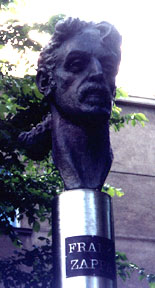 Zappa bust
Zappa bust
It's on private property -- the grounds of a clinic, not a public park -- as the local authorities were less in favor of the bust than was the Lithuanian Frank Zappa Fan Club.
Tallinn was quaint, and Riga had a "yuppie" feel to it. But Vilnius seemed quirky. Perhaps it was the presence of Vilnius University, right in the center of Old Town, that gave the city its "edgy" feel. Maybe it was the derelict artists' neighborhood of Uzupis. Perhaps it was just my predisposition -- my realization that indeed it was unusual to have a monument to the man who named his children Dweezil and Moon Unit, and sang about not eating yellow snow.
Perplexed, I snapped a few photos of the anti-Tipper and then went to find some food. The cafe "Gobi" reportedly served Lithuanian food, so I gave it a try.
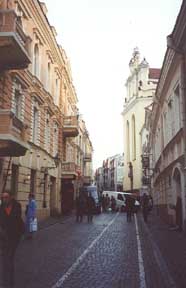
After struggling with the menu for a few minutes, I quietly asked for an English menu. It made only slightly more sense than the Lithuanian one had. There were dumplings with "filling." My allergies dictate constant vigilance regarding food, so I tried to get more specifics.
"What filling?" I asked.
"Meat, cabbage, cheese."
"All of them?"
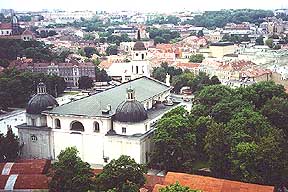 Vilnius
Vilnius
"No."
"One of them."
Blank stare.
I abandoned the idea of dumplings and scanned the herring dishes (fish allergy) and the potato sausage (huh?). My guidebook listed other Lithuanian possibilities as "cow's tongue, pig part appetizers, and intestines." I settled on potato pancakes with cabbage.
It turned out to be nothing like what I expected, based on my experiences at Eastern European diners "Odessa" and "Little Poland" at home. It wasn't even nice enough to meet the low standards of the old "Leshko's" on Avenue A -- a place so charmingly bad, you didn't even have to wait for a brunch table on New Year's Day.
My potato pancake was two parts grease, one part potato, and covered in butter, cole slaw, bacon, sour cream, and dill. I managed to get about six bites down, but couldn't stop thinking of a line in the book "The Angel of Darkness," in which the journalist character comments on Mrs. Leshko's bad cooking: "They only eat it over there because they have to."
I left the potato pancake and went to find a more appealing supper. There were other options: McDonald's, pizza, and atmospheric restaurants filled with couples.
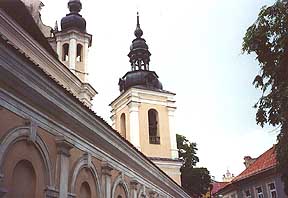
I knew I was lucky. Not everyone gets to quit working and skip around the Baltics looking at Frank Zappa statues. But faced with another night alone in a cute couples restaurant, I was suddenly very lonely. I wanted to meet other freelancers for breakfast burritos at two in the afternoon on Avenue A. I wanted takeout Thai curry, to eat on my Wacom tablet in front of a half-colored cover. Or a brunch of biscuits and gravy at the "Old Devil Moon" with out-of-town guests. Was I homesick, due for a meal with company, or did I just need a nap?
I found a suitably anonymous Italian restaurant, quickly downed some gnocchi, and headed back to the hotel. Maybe I'd feel better tomorrow. My moods were changing frequently.
"Only five more days to Berlin," I thought. "Then I can rest."
JUNE 7
Rain! All over my plans to walk around Vilnius and go to "Stalin World!" No matter, I had a raincoat and would persevere.
But first there was the small matter of extricating myself from the bed, which proved difficult. I promised myself a week of sleep in Berlin, and banana pancakes for breakfast.
The banana pancakes worked. "Da Antonio III" served them drizzled in chocolate and accompanied by espresso.
Supercharged on bananas and caffeine, I went to the bus station to catch one of the hourly buses to Druskininkai.
I asked the driver for a ticket to "Grutas Parkas" -- it wasn't really called "Stalin World," except in hip, English-language magazines. The bus was filled with schoolchildren and seniors, many carrying luggage in plaid, plastic, zippered bags.
During the two-hour ride, I got a feel for how Lithuanians make their way around their small country. The bus was the lifeline along its route, stopping at bus shelters on remote roads that seemed to stretch off into nowhere.
The countryside itself was relatively unpopulated, with the occasional cluster of farmhouses breaking up the forest and yellow-green fields.
I was following our route on a map, and knew when we were getting close. The bus driver slowed, looking directly at me in the rear view mirror. I moved towards the front, ready to disembark quickly. The bus stopped.
"Zwei kilometer," said the driver, motioning to a road on the left. I was to walk two kilometers up that road.
I nodded and left. The bus pulled away in a road, leaving me alone and surrounded by only the sounds of birds, insects, and rustling leaves.
The two kilometer walk was up a country lane. No cars passed. I took my time strolling down the asphalt. The sun was out, the weather was warm, and I was the only tourist for miles.
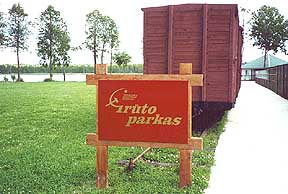 cattle car at Gruto Parkas
cattle car at Gruto Parkas
Gruto Parkas was conceived and financed by Viliumas Malinauskas, a local millionaire who had made his fortune off of canning chantarelle mushrooms. His personal estate was next door to the park, and was marked liberally with "no trespassing" signs.
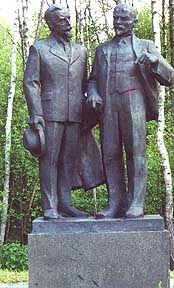
Magazine articles call it either "Stalin World" or a "Soviet theme park." It's actually a sculpture garden, containing only old Soviet propaganda sculptures. When Lithuania declared independence, the Soviet sculptures (many of Lenin and Stalin) were immediately uprooted and left to rot in dumps and junkyards. Malinauskas took it upon himself to commemorate a time no one seemed anxious to remember. He collected the sculptures and brought them to Grutas.

A cattle-car -- the same kind that once took prisoners to Siberia -- marked the main entrance. I walked down the narrow railway-like path to the ticket office, paid my five litas, and walked first to the cafe for some chantarelle mushroom stew. Then, I was ready for a little Red nostalgia.
The site itself was a wooded forest, and the two-kilometer boardwalk wound through the trees and over a swamp. The first sculptures were the most user-friendly; they were just soldiers, or "the people." Then, there was a small museum of Soviet memorabilia and the park kicked into high gear.

There was Lenin standing, Lenin sitting, giant Lenin, small Lenin, Lenin by the same artist who sculpted Frank Zappa, Karl Marx in a variety of poses, and every possible respectable variation of Stalin sculpture. Some sculptures even featured Lenin AND Stalin, a real piece of artistic license as Lenin reportedly did not even like Stalin.
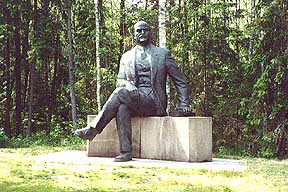
Surrounding all this was a fence of barbed wire, intercut with occasional guard towers. This protection served a double-purpose of keeping out potential saboteurs (not everyone appreciates the park), and giving tourists an idea of what the Gulag looked like. And perhaps, poetically, the fence symbolically keeps Stalin locked in his own Gulag for all eternity.
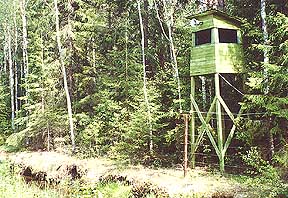 guard tower
guard tower
The park was bizarre, but unfortunately, only took about an hour to get through. The next bus wasn't due for an hour and a half. So I would have to hitchhike to Druskininkai. It wasn't a bad idea, as hitching is quite common in Lithuania, but the problem was that I didn't think I really had it in me to stick out my thumb and ask for a ride.
Did hitchers even use their thumbs in Lithuania? I didn't know. In some countries, you hold your arm out and wave it slightly.
Of course, looking anxious at the bus stop on the road to Druskininkai was not the most effective way to get a ride, but it was all I had the nerve to do. Four cars passed me, and then an old lady with a cow walked by. She chatted to me, probably telling me that I was never going to get a ride like that. Finally, a car pulled up.
The friendly couple inside the car drove me seven kilometers to town. They left me at the outskirts, giving me exactly enough time to have a quick walk through the resort town of Druskininkai before I had to head to the bus station for my ride back to Vilnius.
JUNE 8
After my increasingly usual morning can't/must conflict (*can't* get out of bed, *must* get out of bed), I headed to the Station Market. It was an open-air bazaar down the street from Hotel Mikotel, and looked appealingly local from a distance.
It was local. It was also depressing. Between the cheery vegetable stalls were old women selling second-hand clothes, wildflowers, and ancient household items no doubt picked out of the garbage. I'd seen the same thing in other ex-Soviet countries -- in spite of the economic success stories in the Baltics, people were still struggling.
I caught a tram to the new city, for an expat breakfast of freshly-squeezed orange juice and French toast. The plan was to fortify myself for my trip to the ex-KGB headquarters, now the Museum of Genocide Victims.
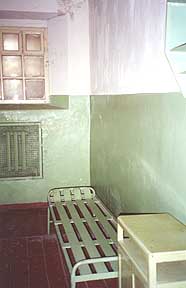 cell in Museum of Genocide Victims
cell in Museum of Genocide Victims
The preparations were for nothing. As it turned out, I still felt sick. I also made it through the museum in record time, feeling no compulsion to linger in the cramped cement cells that once housed political prisoners. Both the KGB and the Nazis had tortured prisoners there and two of the cells still housed the remains of 706 unidentified corpses found in 1994 in a nearby mass grave.
I bolted and headed down busy Gedimino Prospektas towards Old Town.
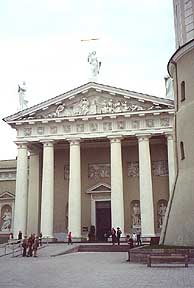 Vilnius cathedral
Vilnius cathedral
Vilnius' Old Town, like Riga's, is a thriving city within a city. It is not just for tourists, and caters more to the 14,000 Vilnius University students than to travelers. The end result is a sort of modern Old Town, where streets are cobblestone but are also smooth and comfortable for cars and foot traffic. The old city blurred into the new at the edges, and I wasn't always sure which part of town I was in.
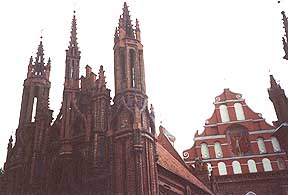
I took a self-guided walking tour, visiting Vilnius Cathedral, the hill above the Cathedral, several churches, and the only surviving original town gate. At twilight, I picked up my luggage and headed to the bus station. My 10:20 p.m. bus to Poland was filled with schoolchildren on holiday, who all giggled well into then night. The bus was old and decrepit, and the driver cranky and tired. It looked dangerous.
"We're going to have an accident," I thought, with great certainty. But there was nothing I could do about it, so I went to sleep.
NEXT: Dazed and numb to history! Gdansk, Marlbork Castle, and boiled pierogies.